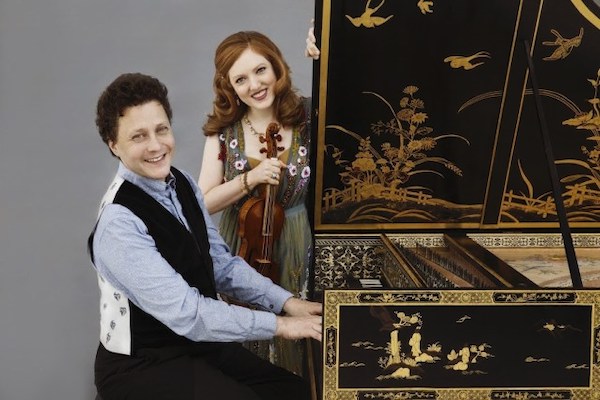Barton Pine and Vinikour team up for intimate Bach at National Gallery

When two gifted solo performers collaborate, the results can vary. Happily the results were positive when violinist Rachel Barton Pine and harpsichordist Jory Vinikour came together to make a fine recording, released last year, of J. S. Bach’s six sonatas for their combined instruments. The pairing sounded even better in person than on disc, when they performed two of these sonatas on the free concert series of the National Gallery of Art Sunday afternoon.
As Barton Pine explained in her informative commentary between pieces, she was playing on a violin Nicolò Gagliano made in 1770. This instrument has remained in its original state, with no alteration to the fingerboard and string tension. With gut strings and a Baroque style bow, it is capable of an extremely delicate tone. Matched with the equally soft sounds of the double-manual harpsichord, made by Thomas and Barbara Wolf after a German model, it made for a most intimate concert.
In the first movement of Sonata No. 1 for Violin and Harpsichord, Barton Pine began her initial long note so quietly that it glowed like a single golden thread hidden in the tapestry of the harpsichord introduction. Vinikour used a fuller registration in this movement, reflecting the greater relative importance of the keyboard part. Softer stops prevailed in the clean runs of the second movement, and a more tinkly color in the gorgeous third movement.
Both players exercised admirable rhythmic flexibility in the slow movements, which heightened the expressive effect of the music. In the peppy fourth movement, taken at a daringly fast speed not implied in the tempo marking, neither musician seemed to produce a single bead of sweat while maintaining a crisply defined pace, perfectly in step with one another.
In the Sonata No. 3, in the brighter key of E major, Barton Pine seemed more in the lead, floating in a limpid tone over the active keyboard part in the first movement. Always sensitive to the way Bach altered the texture, Barton Pine put herself more or less into the background according to the prominence of her part. She and Vinikour lined up with exactitude in the fast movements, especially in the ultra-quick finale, where there was a pleasing contrast between sections in triplets and those in sixteenth notes.
The performers filled out the inner part of the program with one longer solo piece each. Vinikour offered the Ouverture in the French Style, a suite of mostly dance movements. Published in the second volume of Bach’s Clavier-Übung alongside the Italian Concerto, it is a quirky piece meant to spotlight the antiphonal possibilities of a harpsichord with two separate manuals. Taking his cue from Bach’s indications of “piano” and “forte,” Vinikour explored the registration possibilities of this beautiful instrument, especially in the concluding “Echo” movement.
The high point of the recital belonged to Barton Pine, in an accomplished rendition of Solo Violin Partita No. 4. It was also the best part of her 2016 recital at the National Gallery, featuring all six of the solo sonatas and partitas. Back then she played on her 1742 Guarneri del Gesù (“ex-Bazzini, Soldat”), a historic instrument converted into the modern format, but with a Baroque bow. Now with the unaltered Gagliano, an instrument whose tone can almost vanish into a whisper, her interpretation was even more agile and more subtle.
Gut strings at lower tension can still provide some volume and heart-moving resonance, but they also sound more like the human voice, vulnerable and confidential. Barton Pine kept vibrato to a minimum, adding it sometimes as a colorful ornament, but her intonation was so sure that multi-stop chords, in the Sarabande for example, shimmered. As in the sonatas with harpsichord, the runs of the quick-footed Gigue were dazzling in accuracy.
Barton Pine quoted a violinist colleague snidely questioning why she would want to “ride a horse” (her old-style violin) when she could “drive a racecar” with a modern instrument. Her response was that a racecar is all well and good until you have to leap a hedge or ford a river. That image came to mind in the partita’s concluding “Ciaccona,” kept at a mostly strict tempo from section to section. In the off-string variations, her bow moved with such ease and agility and the strings spoke so softly that hidden voices popped unexpectedly out of the texture.
Venue note: The National Gallery of Art may want to reconsider switching back to its previous concert time at 6 p.m. after the museum had closed to visitors. The current start time of 3:30 p.m. gets one home earlier, but the constant dull roar of people in the galleries surrounding the West Garden Court can be quite distracting, especially during a concert as quiet as this one.
The piano duo of Ran Dank and Soyeon Kate Lee performs 3:30 p.m. October 20 in music by Hamelin, Rachmaninoff, Debussy, and Stravinsky at the National Gallery of Art. nga.gov
